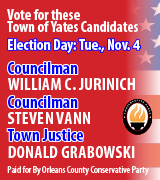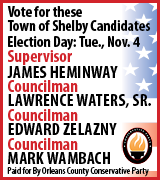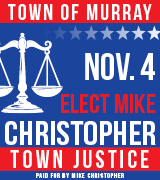John Proctor, a Gaines pioneer, proved his patriotism and love for adopted hometown
By Adrienne Kirby, Town of Gaines Historian
“Illuminating Orleans” – Volume 4, Number 24
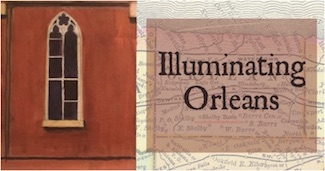
GAINES – Not everybody has loved the patriotic anthem, “God Bless America.” Folk singer Woody Guthrie thought it was downright smarmy.
But, given that the whole United States Congress spontaneously sung it on the steps of the Capitol in the wake of 9/11, it’s fair to say that it has made a deep impression on the American psyche. Today, I wanted to use a few lines from this well-known song as a lens with which to more closely examine both patriotism and the life of one of Gaines’ most notable pioneers, John Proctor.
We typically think of patriotism using symbols common to the entire nation: the flag, the bald eagle, the Statue of Liberty, Mt. Rushmore. These symbols remind us of our history, and they remind us of those ideals that we consider to be distinctly American.
Patriotism is commonly defined as love of one’s country. Early on in “God Bless America,” we find the phrase, “land that I love.” I would posit that one cannot love one’s country unless one also loves a particular locale within that country.
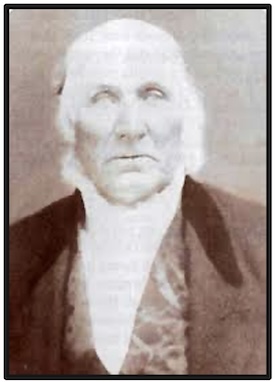
John Proctor, 1787-1868
In other words, love of country is preceded by love of a specific, and much smaller region. Born just a few years after the War of Independence, John Proctor arrived here in 1810 at the age of 23. Two years later, he brought his new bride, Polly, to this crossroads to establish a life together. I think it is safe to say that John had a love of his birthplace, as he made a number of trips back to Massachusetts for visits. But greater still was his love for his home in western New York. He lived here for nearly sixty years.
The anthem continues, “stand beside her.” To stand beside someone or something can mean protecting it; military images are frequently used to symbolize patriotism. But it can also mean to stay faithful when life becomes difficult. John Proctor’s life illustrates both meanings.
Shortly after John had settled in with Polly to make their home, the War of 1812 started. His entry in the book “Pioneers of Orleans County” noted that during the war, a number of other settlers fled the country for fear of the British and Indians. In 1813, he was requested in the middle of the night to quickly alert inhabitants east of here that the British were coming and to take up arms, earning him the moniker of the “Paul Revere of the Ridge.”
He was chosen because he was the only one in the vicinity who owned a horse. He and a group of men that he rounded up during his ride went to a “place called Hardscrabble, near Lewiston” to perform what he called a “sort of garrison duty” for two weeks. Later in the year, he went to Buffalo to help defend against British attacks from Fort Erie, where he experienced some battle. Several men in his company were killed, while John noted that “several bullets passed through my clothes, and one grazed my finger.”
John stood ready to rally support against British troops during the war, and he stood here in Gaines for decades amidst great personal loss. As a historian investigating people who died long before living memory, and with limited resources at my disposal, I sometimes have to infer what people were like both by the things they did based on the records we have, but also sometimes by what they did not do.
John Proctor suffered a great deal of personal tragedy. In the early 1820s, he and Polly endured the loss of two children who never made it past toddlerhood. Both Polly and a two-year-old daughter died within two months of each other during an epidemic in 1828.
In the early days of Gaines, many died from what they referred to as “ague,” or what we would call malaria. Deaths from diseases that we now have vaccines for were all too common.
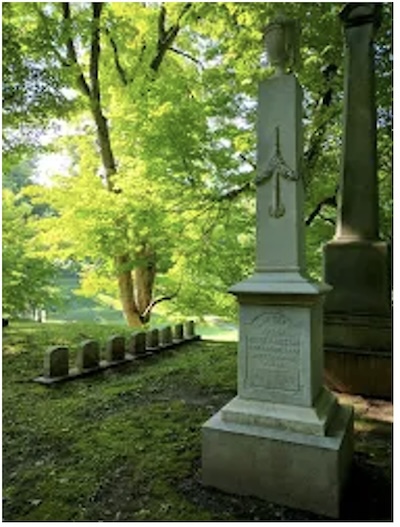
Clarissa Proctor’s monument is shown at Mt. Albion Cemetery. The family monument may be seen behind it. The headstones are for John, his wives and children.
John’s second wife passed away a few months after the birth of his fifth child. Complications in childbirth were also a common cause of death. His daughter Clarissa made it to adulthood and was even married, but she passed away at age 28. John erected a substantial monument in Mt. Albion for his beloved daughter in 1860.
And in 1866, John laid to rest his third wife. After so much grief, a person in his position might have chosen to look to the greener fields of Michigan for a new start. In fact, many individuals and families from Gaines chose to move west over the course of the 1800s. But despite the heartache, he stayed, and his presence must have provided this community a sense of continuity.
The next line in the anthem states, “and guide her.” In the early years of the 19th century, western New York was a place of opportunity, and like many others at the time, John was an entrepreneur, wheeling and dealing in real estate. In this, he was highly successful, and was one of the wealthiest men in Gaines for as long as he lived. Early on, he served in a number of different town offices. He was involved in the formation of the bank and other businesses in Gaines, and held mortgages for poor settlers who were unable to secure bank loans.
At one point, John Proctor owned nearly all the land that can be seen from the crossroads just outside these doors. It is no wonder that in the first half of the 19th century, this place was known as “Proctor’s Corners.” He was wealthy enough, and had enough influence to have made certain that “Proctor’s Corners” would be put on the map. He instead chose to name this hamlet “Fair Haven,” an inviting, welcoming name. One that suggests pleasant respite.
Over time, he sold pieces of land to different buyers, and the hamlet grew, not into a bustling town or village, but into a place where all of one’s basic needs could be met, materially, socially and spiritually. The general store and blacksmith supplied all the material needs that early settlers could not provide on their own. The tavern on the northwest corner was a place to connect with both neighbors and travelers, and was a source of news. And finally, there was the church in which we now sit. John Proctor both funded the construction of this church, and held the mortgage for the first church in Gaines. He fondly remembered, “For many years our religious worship was held in common together, with no denominational distinctions.”
John Proctor was a patriot, not only because he loved this land and did his part in the War of 1812, but he was community oriented. Business-wise, he had an eye as to what would build the area up, and not just for his own gain. As a pioneer, he understood that he and his neighbors were all in it together. He wrote, “Our associations in our wilderness home undergoing fatigue and hardships together, sharing alike in gratitude for every success, and in sympathy for every adversity, bound the early settlers together as a band of brothers.”
As the last line in the song states, John did all he could to make his “Home sweet home” the best it could be for everyone. May we follow his example.














